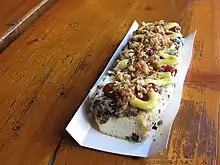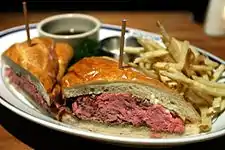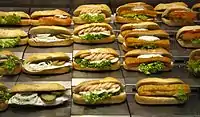Zapiekanka
A zapiekanka (Polish pronunciation: [zapʲɛˈkaŋka]; plural: zapiekanki, pronounced [zapʲɛˈkaŋkʲi]), also known as Polish pizza,[1] is a toasted open-face sandwich made of a sliced baguette or other long roll of bread, topped with sautéed white mushrooms, cheese and sometimes other ingredients such as ham. Served hot with ketchup, it has been a popular street food in Poland since the 1970s.
 A typical zapiekanka served on a paper tray | |
| Alternative names | Polish pizza |
|---|---|
| Type | Street food |
| Place of origin | Poland |
| Associated national cuisine | Polish |
| Invented | 1970s |
| Serving temperature | Hot |
| Main ingredients | Baguette, button mushrooms, cheese |
| Ingredients generally used | Ketchup |
Etymology
The Polish word zapiekanka comes from the verb zapiekać, which means "to bake a dish so that its ingredients combine, and a crispy, browned crust forms on top,"[lower-alpha 1] and may refer to various casseroles and other foods prepared in this manner.[3]
Preparation and varieties

A typical zapiekanka is made from one half of a baguette,[1] or any other long roll of white bread, cut lengthwise, as for a submarine sandwich.[1][4] It may be up to 50 centimetres (20 in) long.[1] The bread is topped with sliced, sautéed white mushrooms and grated cheese to form an open-face sandwich, which is then toasted until the bread becomes crisp and the cheese melts. Hard, mature yellow cheese with high fat content that melts well in heat, such as Gouda, Edam, Emmental, Tilsit or Cheddar, is best for this purpose; Polish smoked sheep milk cheese, such as oscypek, is also a popular choice.[5] A zapiekanka is best served hot. The typical garnish is tomato ketchup, usually splattered on the cheese in a generous amount.[1][4]
Zapiekanki are available throughout Poland in many varieties and levels of quality. Frozen ones, reheated in a microwave oven, are usually soggy and tasteless.[6] Some oven-baked zapiekanki, on the other hand, are available with a lavish choice of additional ingredients and sauces, which has earned them the moniker of "Polish pizza".[1] Varieties include "diablo" with bacon, pickled cucumbers and spicy sauce; "Gypsy" with ham and sweet and sour sauce; "Greek" with olives and feta cheese; and "Hawaiian" with pineapple and barbecue sauce; patrons may also choose their own combinations. While the zapiekanka is primarily a street food, home-made versions also exist, such as the "student's zapiekanka", made from bread, cheese and whatever else is at hand at the moment.[4]
History

Zapiekanki first appeared in the streets of Polish towns in the 1970s. Under Edward Gierek's leadership of the Polish United Workers' Party, Poland's Communist authorities allowed a degree of private enterprise in the catering industry. This move led to quick proliferation of small family-owned foodservice establishments, known in Polish as mała gastronomia, or "small gastronomy". Their spread continued during the food shortages of the following decade. They usually took the form of stands or travel trailers turned food trucks serving zapiekanki along with simple dishes of Polish cuisine, such as kiełbasa sausage, boiled ham hock or tripe soup, and American fast food staples, like hot dogs, hamburgers and French fries.[7][8] The American journalist Anne Applebaum, who first came to Poland in 1988, described the zapiekanka of that time as "a pizzalike substance" and "a poor relative of its distant Italian cousin", "a mushy white sandwich roll" with "a few overcooked mushrooms" beneath "melted cheese and a squeeze of ketchup", which she ate nonetheless because little else was available.[9]
Demand for zapiekanki fell with the reintroduction of market economy in the 1990s, but remained on the menus of some of those "small gastronomy" outlets that survived the competition with large fast food chains. Some zapiekanka stands even attained cult following, such as those located in Plac Nowy (New Square) in the Kazimierz district of Kraków. Once a Jewish neighborhood, Kazimierz declined into desolation following the Holocaust, but experienced a revival after Steven Spielberg shot his 1993 film, Schindler's List, on location there.[10]:133 The dodecagonal brick building constructed in 1900 in the centre of the square, which used to house a kosher butcher's shop, now serves as an outdoor food court operating into the wee hours, with numerous stalls serving a variety of zapiekanki to partygoers made hungry by a night of revelry.[10]:17,76
See also
Notes
- In Polish: piec potrawę w taki sposób, że jej składniki łączą się ze sobą, a na wierzchu powstaje chrupiąca, przyrumieniona warstwa.[2]
References
Sources
- Żmigrodzki, Piotr (ed.). "Zapiekać". Wielki słownik języka polskiego (in Polish). Instytut Języka Polskiego PAN. Retrieved 2015-05-13.
- "Zapiekanka". Słownik języka polskiego (in Polish). Wydawnictwo Naukowe PWN. Retrieved 2015-05-13.
- Bush, Austin (2012). The World's Best Street Food: Where to Find it & How to Make it. Lonely Planet. p. 170. ISBN 978-1742205939.
- Chojnacka, Urszula (2013). "Sery do zapiekania: Gorąca odsłona serów" [Cheeses for baking: The hot role of cheeses]. Forum Mleczarskie Handel (in Polish). Nathusius Investments. 5 (60). Retrieved 2015-05-25.
- Kraig, Bruce; Sen, Colleen Taylor (2013). Street Food Around the World: An Encyclopedia of Food and Culture. Santa Barbara: ABC-CLIO. pp. 280, 471. ISBN 978-1-59884-954-7.
- Kuliś, Agata (2013). "Zapiekanka zapiekance nierówna" [One zapiekanka is not equal to another]. Street Food Polska (in Polish). Sfp14web.
- Chwalba, Andrzej, ed. (2008). Obyczaje w Polsce: Od średniowiecza do czasów współczesnych [Customs of Poland: From the Middle Ages to Modern Times] (in Polish). Warszawa: Wydawnictwo Naukowe PWN. p. 380. ISBN 978-83-01-14253-7.
- "Zapiekanki z "keczukiem" wprost z przyczepy kempingowej: Początki małej gastronomii" [Zapiekanki with "ketchuk" straight from a travel trailer: Beginnings of "small gastronomy"]. TVP Info (in Polish). Telewizja Polska. 2015-03-28. Archived from the original on 2016-10-18. Retrieved 2019-11-30.
- Applebaum, Anne (2013-08-01). "Revolutionary eating in Poland". The Washington Post. Retrieved 2015-05-13.
- Vorhees, Mara (2010). Krakow Encounter. Lonely Planet. ISBN 978-1741048612.



